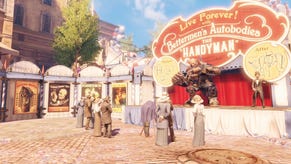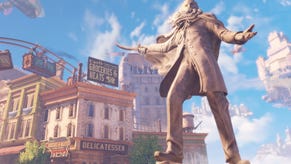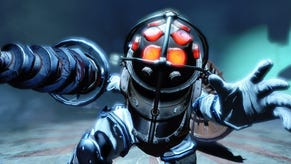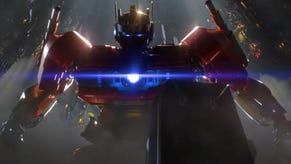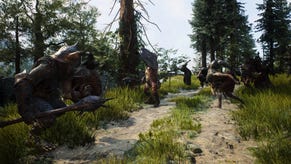BioShock: Infinite’s opening hours: the tip of the iceberg
Three hours spent playing BioShock: Infinite, reveals it to be one of 2013’s most complex and ambitious titles, but can it fully deliver on its potential?
Attempting to piece together the narrative clues contained within the opening hours of BioShock: Infinite feels like trying to decipher Chris Nolan’s Inception after watching it for the first time.
On the surface, it appears to be relatively straightforward and it’s easy enough to explain the gist, but dig a little deeper and it’s clear that there’s much more to be explored. That being the case, let’s just focus on what we know for sure: it’s 1912 and in order to repay a sizeable debt, former Pinkerton agent Booker DeWitt has agreed to retrieve a young girl named Elizabeth from a flying city called Columbia.
Now, let me immediately contradict myself. Through a series of key moments, incidental details and narrative asides, it very quickly becomes apparent that the validity of every single part of that synopsis can be questioned to one degree or another.
Ladies and gentlemen, welcome to BioShock: Infinite.
Evidently, the opening hours of BioShock: Infinite provide a lot to ponder. They also offer up ample opportunity for wholesale bloody violence, but more on that later. First, the script: despite cramming a lot into the three hours that I experienced, very few of Infinite’s most intriguing plot points come by way of heavy-handed exposition. Instead, they play out all around you: in snatches of conversation, audio announcements and fleeting visual scenes. Within the first five minutes, Ken Levine’s intelligent and funny script has me pondering the notion of inevitability, choice, and how video game characters always have very set roles to play.
The opening hours also provide numerous opportunities to learn about Columbia’s origins and its religious ruler, Zachary Comstock. There’s proud discussion of the role that Columbia plays in the wider world and its ideals are loudly trumpeted. The religious fervour on which Columbia sustains itself is celebrated, while its promotion of a racial hierarchy is plainly presented. This latter notion is sometimes violently enforced but more insidious is its normalisation through sugar-coated rhetoric that’s gobbled up by Columbia’s populace like candy cane at a carnival.
The human ingenuity underpinning Columbia as a flying city is magnificent. It’s a place to meander with analogue sticks half-cocked.
Despite its people, the human ingenuity underpinning Columbia as a flying city is magnificent. It’s a place to meander with analogue sticks half-cocked. There’s a lot of enjoyment to be had looking up and around at its towering structures and sweeping vistas or wandering into buildings and strolling through its parks and piazzas. There’s also something to be said for zipping around on Columbia’s skyrail, which takes the notion of video games as rollercoaster rides to its logical conclusion and has the power to be thrilling, disorientating and empowering all at once.
All the fun of the fair
Early on, a carnival provides a wealth of optional content to be explored. Fairground stalls simultaneously act as minor distractions, a place to earn some cash and a tutorial for the game’s gun-play and Vigor powers. They also carry with them a hefty dose of propaganda decrying the existence of the Vox Populi, a rebel faction that was founded to provide Columbia’s minority groups with fair representation but whose methods have turned darker of late.
Needless to say, this relatively gentle introduction to Columbia’s architectural majesty and its sinister society does not last long. While DeWitt is challenged here and there by the local law enforcement soon after arriving in the city, the action becomes significantly more intense once he encounters Elizabeth. Soon after their initial meeting they are escaping a crumbling edifice and being thrust into several fire fights. It’s here that two of BioShock: Infinite’s other defining characteristics reveal themselves: combat and Elizabeth’s role as an AI companion.
The fundamental basis of the combat operates in much the same way as in the first two BioShock games. Through a combination of gun-play and DNA-altering powers known as Vigors (fuelled by Salts) DeWitt tackles a number of human and mechanical foes that make up Columbia’s security forces. DeWitt gains access to a number of Vigors relatively early on, but with a lot of new toys at hand and limited salts to power them, the potential for gleeful experimentation is limited. This proves to be a hindrance to enjoying the combat and naturally pushes you more toward gun-play. It becomes apparent that, as was the case with Rapture’s murderous inhabitants, Columbia’s AI has a penchant for aggressive acts and pays little mind to self-preservation.
Who’s that girl?
Elizabeth quickly reveals herself to be a capable and useful ally. In combat, she stays out of harm’s way and actually appears invulnerable. She can also pick locks and helps counter the problem of a lack of salts with which to power the Vigors, by scouting the battlefield for useful items to provide to you. However, Elizabeth’s show-stopping talent is her ability to open inter-dimensional tears in order to provide access to half-visible anomalies dotted throughout the world. These include helpful items and some more ‘substantial elements’ of narrative importance.
The opening hours of BioShock: Infinite raise more questions than they answer: the kind that have you pondering the meaning of a seemingly incidental detail, a curious turn of phrase or the presentation of a particular narrative thread.
DeWitt’s initially gruff demeanour is softened by interactions with his AI partner but while communication between the pair is, for the most part, a joy to behold I do encounter a jarring example of an explicit lack of consistency. Shortly after a scripted moment in which Elizabeth is horrified by the violent action that DeWitt takes to protect them against assailants, I decide to murder a random innocent civilian. Elizabeth doesn’t bat an eyelid. In fact, not 5 seconds later she cheerfully comments on a children’s carousel. It’s a jarring contrast between what the game wants you to believe about Elizabeth and how it then fails to react to your own unpredictable actions. Hopefully, these instances in which Infinite undermines your ability to suspend disbelief will be few and far between.
Overall, the opening hours of BioShock: Infinite raise more questions than they answer. In one or two instances these are questions of game balance, behavioural consistency and whether the ambition of Levine, Irrational and 2K can truly be met. For the most part, though, they are exciting questions; the kind that have you pondering the meaning of a seemingly incidental detail, a curious turn of phrase or the presentation of a particular narrative thread. They are the kinds of questions that drive you to seek out other people with a shared experience in order to swap theories, trade tid-bits and compare notes.
Ultimately, they are the kinds of questions that should lead you to very much look forward to BioShock: Infinite’s launch on March 26 2013.




